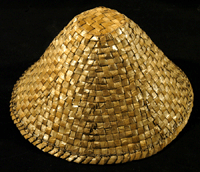Life at Fort Clatsop
Life in the Coastal Communities
| | |
Life in the Coastal Communities
Native Americans living along the Pacific coast of what is now Oregon
and Washington considered
cedar trees to be sacred gifts and the materials taken them living symbols
of their relationship to their environment. The American explorers quickly
saw the utilitarian benefit of using hats like this one. Woven of cedar bark
alone or of cedar twined with beargrass or sedge grass, they were light and
waterproof.
Lewis reported in January 1806, that the hats were “more durable than chip or straw.” However, rather than adopting the well-designed garb of the indigenous population, the Americans insisted on wearing buckskin shirts and pants that absorbed moisture and gradually rotted off of their bodies during the damp Oregon winter.
Beargrass (Xerophyllum tenax) grows in mountainous areas of the Pacific Northwest. Beargrass combined with cedar helped make light, watertight containers and waterproof hats. In this damp climate, people preferred woven capes to water-absorbing skin shirts. Beargrass was a staple of the Columbia River trade. Gathered by women in June, processed and dried by them at lower elevations and formed into bundles, it was a commodity nearly every coastal community could use. German botanist Frederick Pursh prepared this illustration from specimens gathered by the Corps of Discovery.
Bill James. Cedar Hat, modern.
Frederick Pursh. “Beargrass,” in Flora Americanae
Septentrionalis, 1814.
|

| Click to Enlarge | Courtesy of Bud Lane |

| Click to Enlarge | Newberry Library |
|

